by Patrick Roefflaer
This is the 25th album of Bob Dylan’s for which the art work has been reviewed. Details of the previous articles can be found here.
41 – Triplicate
- Released March 31, 2017
- Photographer John Shearer
- Liner Notes Tom Piazza
- Art-director Geoff Gans
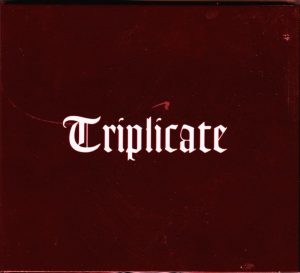 Following Shadows In The Night and Fallen Angels, Bob Dylan released a third selection from the Great American Songbook. Again all these song were previously recorded by Frank Sinatra, between 1939 and 1964.
Following Shadows In The Night and Fallen Angels, Bob Dylan released a third selection from the Great American Songbook. Again all these song were previously recorded by Frank Sinatra, between 1939 and 1964.
Although these 30 songs could easily fit on two vinyl albums, Dylan chose to present them as a three-disc set, each individually titled and presented in a thematically-arranged 10-song sequence. Perhaps it’s his homage to the inventor of the concept album?
At first glance, the art-work for Triplicate appears to be very minimalist, especially for a triple album. On the front, only the album’s title is featured, printed in white lettering against a glossy, deep purple background. On the back there’s the name of the singer above three vertical rectangles. In each of these, the title of the individual LPs is printed above a list of the song titles (No writers/composer’s credits).
Underneath these rectangles there’s just one more piece of information: “Produced by Jack Frost”.
That’s it.
The title, Triplicate, can be seen as another reference to Sinatra, who’s 1980 Reprise 3LP set is called Trilogy: Past Present Future. Dylanologist Andreas Volkert however has discovered that in 1876 a set of playing cards was manufactured by Andrew Dougherty called Triplicate. A replica of this set was reissued in 2014. This may seem far-fetched, but another set by the same manufacturer, Chinese Dragon Back No. 81, is depicted on the cover of Fallen Angels.
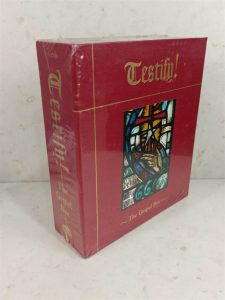 The font on the cover is Goudy Text, which was designed in 1928 by Frederic W. Goudy, based on Gutenberg’s 42-line bible. That same typeface was used on Testify! The Gospel Box, a 3 cd-box, released by Rhino Records, in June 1999. (Remember that Geoff Gans, who did the artwork for Triplicate is an ex-Rhino art director.) That box set design was presented as a kind of prayer book.
The font on the cover is Goudy Text, which was designed in 1928 by Frederic W. Goudy, based on Gutenberg’s 42-line bible. That same typeface was used on Testify! The Gospel Box, a 3 cd-box, released by Rhino Records, in June 1999. (Remember that Geoff Gans, who did the artwork for Triplicate is an ex-Rhino art director.) That box set design was presented as a kind of prayer book.
However Dylan (or Gans) adds another layer.
In the Roaring Twenties of last century, the 78 rpm shellac disc became the recording standard for the music industry. The time limit of 3 1⁄2 minutes on a 10-inch was enough for most popular songs. But even 12-inch 78s could only give about 4–5 minutes per side, which was not nearly enough for classical-music.
 In the 1930s, record companies began issuing collections of 78 rpm records in specially assembled packages, which included three or four records, with two sides each, making six or eight times 3½ minutes for a longer work. The individual records were housed in paper sleeves, with a paperboard or leather cover on the front and the back. The covers of these bound books were wider and taller than the records inside, allowing the record album to be placed on a shelf upright, like a book, suspending the fragile records above the shelf and protecting them. Some artwork was provided on the front cover and liner notes on the back or inside cover.
In the 1930s, record companies began issuing collections of 78 rpm records in specially assembled packages, which included three or four records, with two sides each, making six or eight times 3½ minutes for a longer work. The individual records were housed in paper sleeves, with a paperboard or leather cover on the front and the back. The covers of these bound books were wider and taller than the records inside, allowing the record album to be placed on a shelf upright, like a book, suspending the fragile records above the shelf and protecting them. Some artwork was provided on the front cover and liner notes on the back or inside cover.
As this design resembled that of photo albums, the were called “Record albums”, or simply albums. Later on, when the 33 rpm 12 inch Long Player was introduced, the name “album” stuck in the US, while in Great Britten the name Long Player or LP was preferred.
The artwork of Dylan’s triplicate not only refers to the prayer book, but also to the way records were released before the LP. Frank Sinatra’s first studio album was released by Columbia Records, on March 4, 1946 as an album with four shellac 10-inches.
As Dylan said in his New York Times interview to promote Time Out Of Mind (September 29, 1997): “These old songs are my lexicon and my prayer book … All my beliefs come out of these old songs, literally anything from ‘Let Me Rest on that Peaceful Mountain’ to ‘Keep on the Sunny Side’.”
Back to Triplicate.
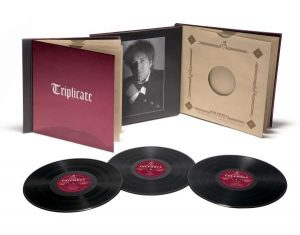 Opening the front cover, there’s a full page black and white portrait of the singer. This photo hides a long essay by novelist Tom Piazza. It’s the first time liner notes have appeared in a Dylan studio album since Dylan’s self-penned notes for World Gone Wrong in 1993.
Opening the front cover, there’s a full page black and white portrait of the singer. This photo hides a long essay by novelist Tom Piazza. It’s the first time liner notes have appeared in a Dylan studio album since Dylan’s self-penned notes for World Gone Wrong in 1993.
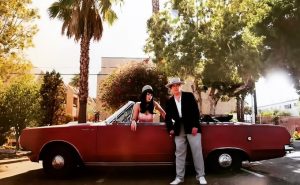 The text is illustrated with a second photo – this time in colour, of Dylan standing in front of a red convertible with a pretty girl inside the car. In the background are palm trees.
The text is illustrated with a second photo – this time in colour, of Dylan standing in front of a red convertible with a pretty girl inside the car. In the background are palm trees.
The girl is most likely Tracy Phillips, actress, dancer, and choreographer. She’s the daughter of football coach Wade Phillips.  Tracy also appears in the “The Night We Called It A Day” video, where she is wearing a blonde wig. Another photo from the same series was used on the back of the “Beaten Path” catalogue (2016). Both the Triplicate photos as the one in the catalogue were made by John Shearer.
Tracy also appears in the “The Night We Called It A Day” video, where she is wearing a blonde wig. Another photo from the same series was used on the back of the “Beaten Path” catalogue (2016). Both the Triplicate photos as the one in the catalogue were made by John Shearer.
In the Wikipedia page for Triplicate the photographer is referred to another John Shearer (April 21, 1947 – June 22, 2019). While the deceased photographer, writer, and filmmaker is best known for his photojournalism, especially of “racial subjects”, the actual Triplicate photographer is still alive. The real Shearer is living in Nashville and is specialized in entertainment portraiture, backstage coverage, and live-music photography. On his Instagram and also on his website, there is a post with Bob Dylan leaning against what looks to be the same car.
Shearer was first associated with Bob Dylan for the cover of Tempest (2012) and since was called upon when some publicity photos were needed for whiskey, ironworks, catalogue for paintings , or indeed album artwork.
PS: The Goudy Text typeface is used for the artwork of the digital single ‘Murder Most Foul’.
——————————–
Untold Dylan was created in 2008 and is currently published twice a day – sometimes more, sometimes less. Details of some of our series are given at the top of the page and in the Recent Posts list, which appears both on the right side of the page and at the very foot of the page (helpful if you are reading on a phone). Some of our past articles which form part of a series are also included on the home page.
Articles are written by a variety of volunteers and you can read more about them here If you would like to write for Untold Dylan, do email with your idea or article to Tony@schools.co.uk. Our readership is rather large (many thanks to Rolling Stone for help in that regard). Details of some of our past articles are also included on the home page.
We also have a Facebook site with some 14,000 members.

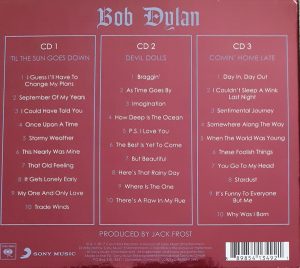
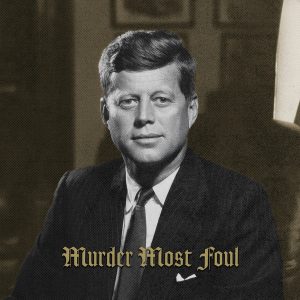
Hi Tony I always like reading music back stories. I worked in record manufacturing in the 70s and 80s most of the time in jacket store so read covers alot.
CBS gave all staff a box set of the 50
Biggest selling single for CBS for 50th Aniversary of Australian existence. Some songs I know alot were not hits just biggest CBS.
It’s an interesting part of my collection. I think we had ten presses in the room. Big mother fucker machines. It was a skill keeping I forget name but the reverse of master. Inspectors would listen to first press then every 100 or so. A conveyor would take the trim venal back to venal room it was used for the cheaper things like 25 smash summer hits.
Classic records got Virginia venal Classical got special treatment.
The covers(jackets) came from CBS printers across town. The cardboard used to print set ups were used in the box of 25 records.
One came in perfect print of Bob Dylan’s Masterpiece triple album.
With Meat Loaf Bat out of Hell printed on top. The positioning was perfect a real keeper. I wrapped it up put it away at parents house. One of my siblings took it.
It’s out there somewhere. I have told that story many times in the hope someone has seen it.
Hope your year is a great one
Michael Crampton